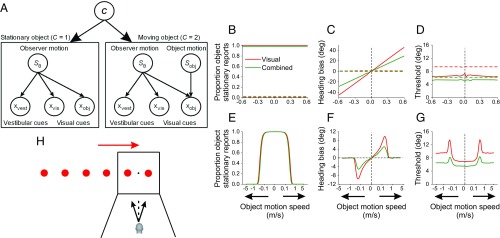Fig. 1.
Task design and model simulations. (A) Graphical model illustrating relationships between the variables implicated in perception of object motion and self-motion. Sobj and Sθ represent the motion of the object and the observer in the world, respectively. xvest and xvis represent the noisy inertial (vestibular) and visual (optic flow derived) heading cues, respectively. xobj is the noisy image motion of the object relative to the observer. Inertial cues only contribute to self-motion perception during multisensory stimulation. Left and Right illustrate the generative models for the cases of a stationary object (C = 1) and a moving object (C = 2), respectively. (B–D) Simulations of the Integration (Int, solid lines) and Segregation (Seg, dashed lines) models (SI Appendix). Colored lines represent simulations for the visual (red) and combined visual–vestibular (green) self-motion conditions. Note that small vertical offsets have been added to the green lines in B (solid and dashed lines) and C (dashed line) to improve visualization; otherwise, green and red horizontal lines would be superimposed. (E–G) Simulations of the OCI model. Predicted proportion of object stationary reports (B and E), bias in perceived heading (C and F), and heading discrimination threshold (D and G) are shown for each of the models. Arrows on the x axis indicate rightward and leftward motion of the object. For each combination of object motion speed, direction of object motion, and heading, the proportion of rightward heading responses was computed and psychometric functions were fitted to the simulated responses (hence the variability in the predictions). (H) To test model predictions, subjects experienced forward translation to the left or right of straight ahead (black arrows) while viewing a multipart object that was either stationary or moved independently rightward (red arrow) or leftward in the world at different speeds. The object was composed of six identical and equidistant spheres. The spheres moved together as a single compound object, such that two of the spheres were always visible on the display throughout the trial at all object motion speeds. For rightward motion of the object, the two rightmost spheres were displayed on the screen at the start of the trial (as illustrated here, see also Movie S1), and vice versa for leftward object motion.

